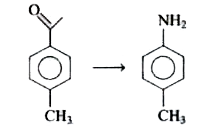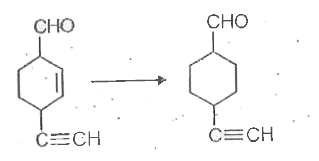The most suitable reagent for the following conversion is Benzamide Reagent−−−−→ Benzylamine
Br2+KOH
LiAlH4
Conc.HNO3
Aqueous KOH
The correct Answer is:1
To convert benzamide to benzylamine, we need to perform a reduction reaction. Here’s a step-by-step solution to identify the most suitable reagent for this conversion:
Step 1: Understand the Structures
- Benzamide has the structure:
C6H5C(O)NH2
This contains a benzene ring attached to a carbonyl group (C=O) and an amine group (NH2).
- Benzylamine has the structure:
C6H5CH2NH2
This contains a benzene ring attached to a methylene group (CH2) and an amine group (NH2).
Step 2: Identify the Reaction Type
The conversion from benzamide to benzylamine involves the reduction of the carbonyl (C=O) group in benzamide to a methylene (CH2) group in benzylamine.
Step 3: Analyze the Reagents
1. Br2 in KOH: This is known as the Hofmann bromamide reaction, which converts amides to amines but also reduces the carbon count. This would yield aniline instead of benzylamine, so it is not suitable.
2. LiAlH4 (Lithium Aluminum Hydride): This is a strong reducing agent that can effectively reduce the carbonyl group in benzamide to a methylene group, yielding benzylamine.
3. Concentrated HNO3: This is an oxidizing agent and would not facilitate a reduction reaction. Thus, it is not suitable.
4. Aqueous KOH: This is a hydrolyzing agent and does not perform reduction. Therefore, it is not suitable.
Step 4: Conclusion
The most suitable reagent for converting benzamide to benzylamine is LiAlH4.
Final Answer
LiAlH4 is the correct reagent for the conversion of benzamide to benzylamine.
---
- Benzamide has the structure:
C6H5C(O)NH2
This contains a benzene ring attached to a carbonyl group (C=O) and an amine group (NH2).
- Benzylamine has the structure:
C6H5CH2NH2
This contains a benzene ring attached to a methylene group (CH2) and an amine group (NH2).
The conversion from benzamide to benzylamine involves the reduction of the carbonyl (C=O) group in benzamide to a methylene (CH2) group in benzylamine.
1. Br2 in KOH: This is known as the Hofmann bromamide reaction, which converts amides to amines but also reduces the carbon count. This would yield aniline instead of benzylamine, so it is not suitable.
The most suitable reagent for converting benzamide to benzylamine is LiAlH4.
LiAlH4 is the correct reagent for the conversion of benzamide to benzylamine.
Similar Questions
Knowledge Check
The suitable reagents for the following reaction are:
 APCl5−−→NaOH−−−→Δ−−→BI2+NaOH−−−−−−→H⊕−−→NH3−−−−−→ΔBr2+KOH−−−−−−→CNH2OH−−−−→PCl5−−→dil.NaOH−−−−−−−−→ΔN3H−−−−−→ΔDH2N−OH−−−−−−→Δ−−→
APCl5−−→NaOH−−−→Δ−−→BI2+NaOH−−−−−−→H⊕−−→NH3−−−−−→ΔBr2+KOH−−−−−−→CNH2OH−−−−→PCl5−−→dil.NaOH−−−−−−−−→ΔN3H−−−−−→ΔDH2N−OH−−−−−−→Δ−−→
Suggest a reagent for the following conversion.

View SolutionThe reagents(s) for the following conversion,
 is :
is :
View SolutionThe suitable reagent for the following reactions is

View SolutionThe reagent(s) for the following conversion

is/are:
View SolutionThe reagent(s) for the following conversion

is/are:
View SolutionThe reagent (s) for the following conversion ,

is /are
View SolutionThe most suitable reagent for given conversion is

View Solution


